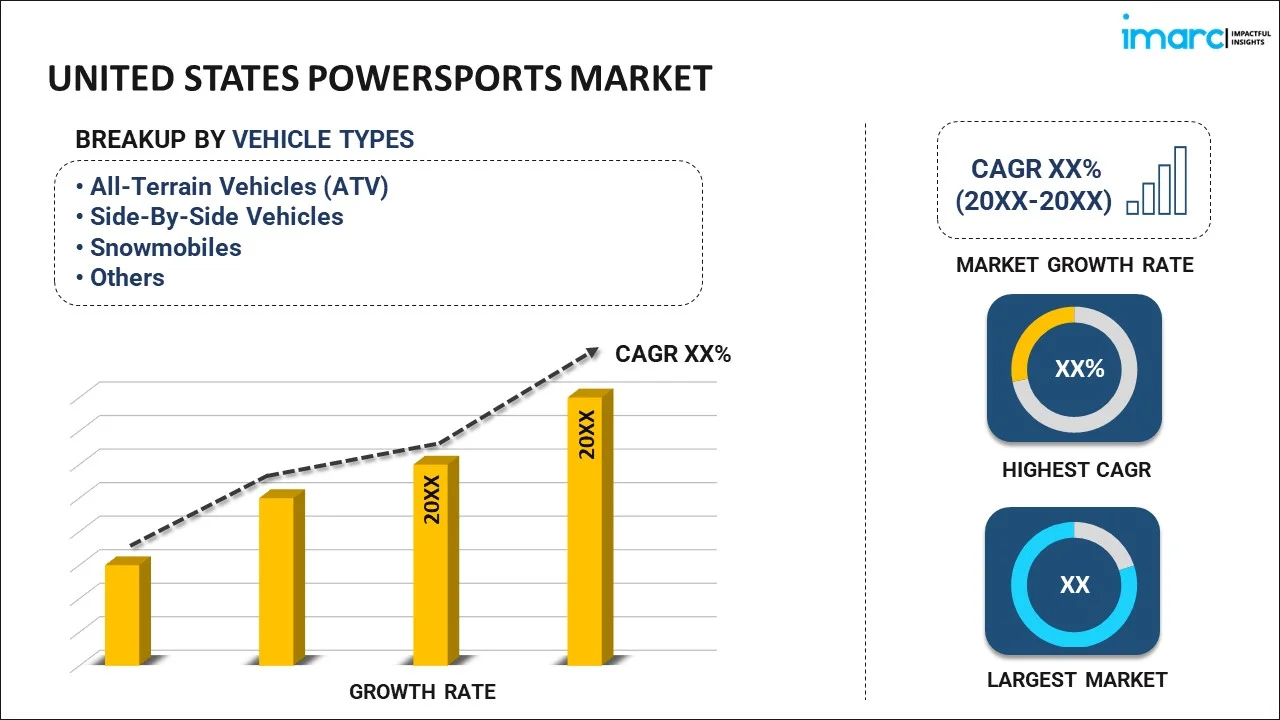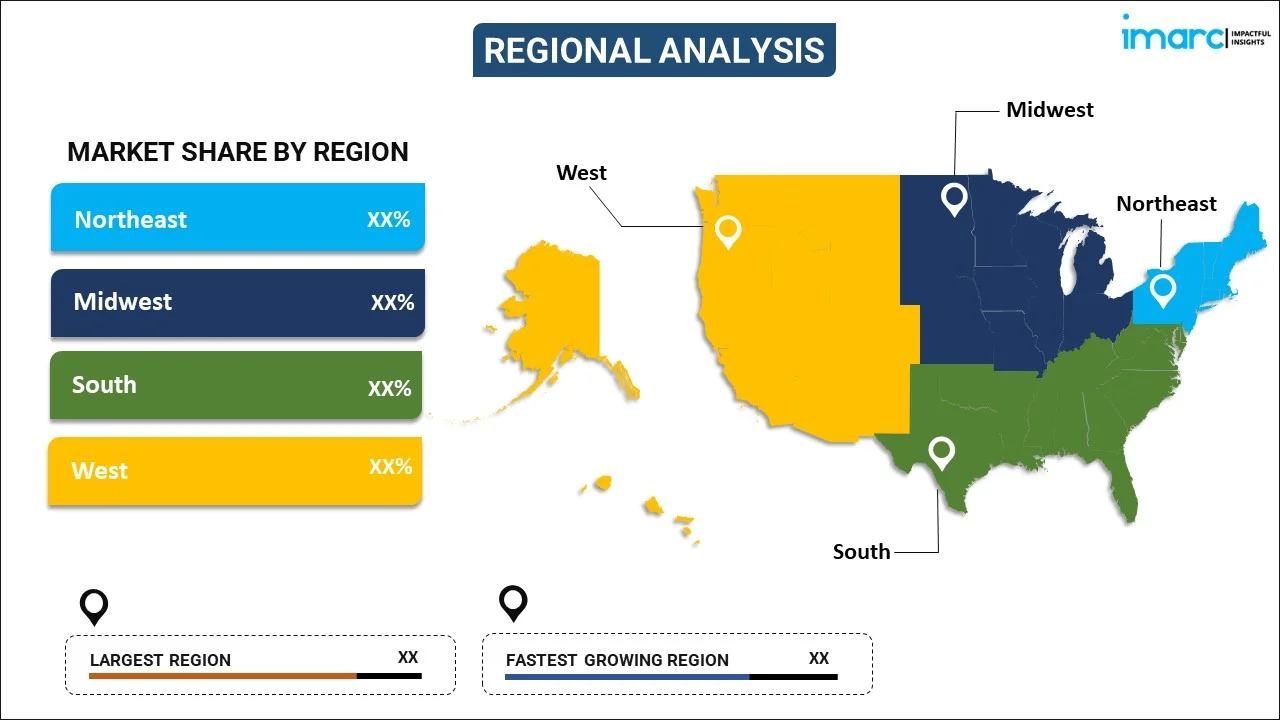
United States Powersports Market Report by Vehicle Type (All-Terrain Vehicles (ATV), Side-By-Side Vehicles, Snowmobiles, Personal Watercraft, Heavyweight Motorcycle), Propulsion Type (Gasoline, Electric, Diesel), Application (On-Road, Off-Road), and Region 2025-2033
Market Overview:
United States powersports market size reached USD 8,663.1 Million in 2024. Looking forward, IMARC Group expects the market to reach USD 14,223.8 Million by 2033, exhibiting a growth rate (CAGR) of 5.66% during 2025-2033. The rising disposable income, a cultural shift towards outdoor recreation, technological advancements in high-performance vehicles, increased interest in off-road activities, and a surge in customization trends represent some of the key factors driving the United States powersports market share.
|
Report Attribute
|
Key Statistics
|
|---|---|
|
Base Year
|
2024 |
|
Forecast Years
|
2025-2033
|
|
Historical Years
|
2019-2024
|
| Market Size in 2024 | USD 8,663.1 Million |
| Market Forecast in 2033 | USD 14,223.8 Million |
| Market Growth Rate (2025-2033) | 5.66% |
United States Powersports Market Analysis:
- Key Market Trends: some of the key United States powersports market trends are the electric powersports vehicles, smart tech integration, and adventure tourism are trending. Consumers favor connected experiences, sustainability, and seasonal recreation, driving innovation in design, features, and environmentally conscious vehicle options.
- Major Drivers: Outdoor recreation demand, technological advancements, and dealership expansion fuel market growth. Rising interest in lifestyle vehicles and improved access to rentals or financing are key momentum factors across demographics.
- Market Opportunities: Expanding electric vehicle offerings, digital retail platforms, and new rental models present growth avenues. Targeting youth markets and urban users with compact, tech-savvy vehicles can unlock untapped customer segments.
- Market Challenges: High vehicle costs, regulatory hurdles, and environmental concerns challenge growth along with the limited infrastructure for electric models and seasonal dependence can hinder consistent sales and discourage entry for price-sensitive consumers in the United States powersports market analysis.
Powersports refers to a category of recreational and motorized vehicles designed for outdoor activities, providing enthusiasts with thrilling and adventurous experiences. This diverse segment encompasses a range of vehicles, including motorcycles, all-terrain vehicles (ATVs), snowmobiles, personal watercraft, and off-road vehicles. Powersports vehicles are characterized by their high-performance engines and specialized designs tailored for various terrains and activities such as motorcycles, which are two-wheeled vehicles designed for on-road travel, offering a sense of freedom and speed. Besides this, ATVs are versatile four-wheelers designed for off-road exploration, agricultural work, or recreational trail riding. Snowmobiles are motorized sleds built to traverse snow-covered landscapes, while personal watercraft like jet skis provide aquatic thrills. Powersports enthusiasts engage in activities such as off-roading, trail riding, racing, and water-based adventures, contributing to the popularity and growth of the powersports industry. The appeal of these vehicles lies in their ability to combine adrenaline-fueled experiences with outdoor recreation, attracting a diverse community of riders and adventurers.
United States Powersports Market Trends:
Rising Consumer Interest in Outdoor Recreation
Outdoor and adventure-based recreation continues to become more popular and forcefully leads the U.S. powersports industry. Off-roading, snowmobiling, and personal watercraft riding have all increased significantly, particularly following the COVID-19 pandemic, which placed consumer interest in socially distanced activities. Powersports machinery—such as ATVs, UTVs, and dirt bikes—allows its users to ride trails, forests, and lakes, providing excitement and freedom. As Americans spend more on recreational pursuits and weekend vacations, demand for these units keeps growing. Government assistance for the development of more recreational trails and parks further increases participation. In addition, the popularity of adventure tourism and outdoor lifestyle pursuits in social media increases visibility and aspirational demand. This expanding interest also shapes gear, accessories, and services related to powersports, fueling a wider ecosystem. On the whole, lifestyle congruence and greater accessibility make outdoor recreation an exceptionally strong, sustainable force within the powersports market thereby bolstering the United States powersports market demands.
Technological Advancements and Product Innovation
Ongoing innovation in powersports vehicles plays a major driving force for the U.S. market. Companies are incorporating new technologies like GPS navigation, ride-by-wire, better suspension, and smartphone integration to advance safety, performance, and customer experience. Electric powersports vehicles are becoming increasingly popular as environmental concerns mount, and battery life, torque, and range improve. Moreover, ergonomic styling, customizable elements, and intelligent diagnostics enhance the attractiveness of vehicles to both new and seasoned riders. Polaris, Can-Am, and Yamaha are heavily investing in R&D to distinguish products and address changing customer needs. Such leaps in technology not only draw new customers but also induce frequent replacement among current users. As safety technology continues to advance—such as anti-lock braking systems and traction control—powersports vehicles increase their availability to a wider audience, including younger and less experienced users. Innovation, therefore, is key to maintaining long-term market expansion and competitiveness.
Expanding Powersports Dealership and Rental Networks
Expansion of dealership and rental networks has expanded access to powersports vehicles throughout the United States powersports market growth. Dealerships offer on-the-ground experiences, professional guidance, maintenance, and financing, facilitating purchasing and ownership for the consumer. Furthermore, rental organizations and adventure tour operators enable individuals to participate in the powersports experience without the cost of initial ownership. This "try before you buy" approach is especially potent at turning occasional riders into repeat customers. Vacation and seasonal rentals in areas of high resort popularity such as the Rockies, Florida, and the Southwest are huge, exposing the lifestyle to a wider audience. Furthermore, online platforms for reserving rentals or purchasing used vehicles further ease access. The growing rental and dealer network facilitates market penetration across urban, suburban, and rural markets, enhancing brand recognition as well as user activation across the powersports space.
United States Powersports Market Segmentation:
IMARC Group provides an analysis of the key trends in each segment of the market, along with forecasts at the country level for 2025-2033. Our report has categorized the market based on vehicle type, propulsion type, and application.
Vehicle Type Insights:

To get more information on this market, Request Sample
- All-Terrain Vehicles (ATV)
- Side-By-Side Vehicles
- Snowmobiles
- Personal Watercraft
- Heavyweight Motorcycle
The report has provided a detailed breakup and analysis of the market based on the vehicle type. This includes all-terrain vehicles (ATV), side-by-side vehicles, snowmobiles, personal watercraft, and heavyweight motorcycle.
Propulsion Type Insights:
- Gasoline
- Electric
- Diesel
A detailed breakup and analysis of the market based on the propulsion type have also been provided in the report. This includes gasoline, electric, and diesel.
Application Insights:
- On-Road
- Off-Road
The report has provided a detailed breakup and analysis of the market based on the application. This includes on-road and off-road.
Regional Insights:

- Northeast
- Midwest
- South
- West
The report has also provided a comprehensive analysis of all the major regional markets, which include Northeast, Midwest, South, and West.
Competitive Landscape:
The market research report has also provided a comprehensive analysis of the competitive landscape. Competitive analysis such as market structure, key player positioning, top winning strategies, competitive dashboard, and company evaluation quadrant has been covered in the report. Also, detailed profiles of all major companies have been provided.
Latest News and Developments:
- In June 2025, BRP Inc. has launched its first European flagship store in Paris, showcasing its Can-Am on-road lineup, including the new electric motorcycles—Can-Am Pulse and Origin. Operated by Canadian Motors, the 144 m² store offers immersive brand experiences. Highlighting BRP’s electric innovation, the models feature fast-charging, liquid-cooled Rotax E-Power units, and customizable accessories—catering to urban commuters and advancing BRP’s growth and commitment in the European powersports market.
- In April 2025, Massimo Motor has unveiled a new online sales platform, revolutionizing powersports retail by offering end-to-end digital services—from financing to checkout. This move enhances national reach, streamlines the customer experience, and integrates seamlessly with local dealerships. Expected to significantly boost sales and market penetration, the platform marks a key step in Massimo’s innovation strategy and sets a new standard for powersports e-commerce in the U.S.
United States Powersports Market Report Coverage:
| Report Features | Details |
|---|---|
| Base Year of the Analysis | 2024 |
| Historical Period | 2019-2024 |
| Forecast Period | 2025-2033 |
| Units | Million USD |
| Scope of the Report | Exploration of Historical and Forecast Trends, Industry Catalysts and Challenges, Segment-Wise Historical and Predictive Market Assessment:
|
| Vehicle Types Covered | All-Terrain Vehicles (ATV), Side-By-Side Vehicles, Snowmobiles, Personal Watercraft, Heavyweight Motorcycle |
| Propulsion Types Covered | Gasoline, Electric, Diesel |
| Applications Covered | On-Road, Off-Road |
| Regions Covered | Northeast, Midwest, South, West |
| Customization Scope | 10% Free Customization |
| Post-Sale Analyst Support | 10-12 Weeks |
| Delivery Format | PDF and Excel through Email (We can also provide the editable version of the report in PPT/Word format on special request) |
Key Benefits for Stakeholders:
- IMARC’s industry report offers a comprehensive quantitative analysis of various market segments, historical and current market trends, market forecasts, and dynamics of the United States powersports market from 2019-2033.
- The research report provides the latest information on the market drivers, challenges, and opportunities in the United States powersports market.
- Porter's five forces analysis assist stakeholders in assessing the impact of new entrants, competitive rivalry, supplier power, buyer power, and the threat of substitution. It helps stakeholders to analyze the level of competition within the United States powersports industry and its attractiveness.
- Competitive landscape allows stakeholders to understand their competitive environment and provides an insight into the current positions of key players in the market.
Key Questions Answered in This Report
The powersports market in the United States valued at USD 8,663.1 Million in 2024.
The United States powersports market is projected to exhibit a CAGR of 5.66% during 2025-2033, reaching a value of USD 14,223.8 Million by 2033.
Key factors driving the United States powersports market include rising interest in outdoor recreation, technological advancements in vehicle design and electrification, and expanding digital and dealer-based retail networks. Consumer demand for adventure, convenience, and performance continues to fuel growth, along with increased accessibility through financing, rentals, and e-commerce platforms.
Need more help?
- Speak to our experienced analysts for insights on the current market scenarios.
- Include additional segments and countries to customize the report as per your requirement.
- Gain an unparalleled competitive advantage in your domain by understanding how to utilize the report and positively impacting your operations and revenue.
- For further assistance, please connect with our analysts.
 Request Customization
Request Customization
 Speak to an Analyst
Speak to an Analyst
 Request Brochure
Request Brochure
 Inquire Before Buying
Inquire Before Buying




.webp)




.webp)












